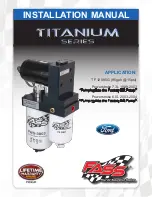
the outside temperature decreases, the tire pressure will
decrease. Tire pressure should always be set based on
cold inflation tire pressure. This is defined as the tire
pressure after the vehicle has not been driven for at least
three hours, or driven less than 1 mile (1.6 km) after a
three-hour period.
Refer to “Tires – General Informa-
tion” in “Starting and Operating” for information on
how to properly inflate the vehicle’s tires.
The tire
pressure will also increase as the vehicle is driven - this is
normal and there should be no adjustment for this
increased pressure.
The TPMS will warn the driver of a low tire pressure if
the tire pressure falls below the low pressure warning
threshold for any reason, including low temperature
effects, or natural pressure loss through the tire.
The TPMS will continue to warn the driver of low tire
pressure as long as the condition exists, and will not turn
off until the tire pressure is at or above recommended
cold tire pressure. Once the low tire pressure warning has
been illuminated, the tire pressure must be increased to
the recommended cold tire pressure in order for the “Tire
Pressure Monitoring Telltale Light” to be turned off. The
system will automatically update and the “Tire Pressure
Monitoring Telltale Light” will extinguish once the up-
dated tire pressures have been received. The vehicle may
need to be driven for up to 20 minutes above 15 mph
(24 km/h) to receive this information.
For example, your vehicle has a recommended cold
(parked for more than three hours) tire pressure of 33 psi
(227 kPa). If the ambient temperature is 68°F (20°C) and
the measured tire pressure is 28 psi (193 kPa), a tempera-
ture drop to 20°F (-7°C) will decrease the tire pressure to
approximately 24 psi (165 kPa). This tire pressure is
sufficiently low enough to turn ON the “Tire Pressure
Monitoring Telltale Light.” Driving the vehicle may cause
the tire pressure to rise to approximately 28 psi (193 kPa),
but the “Tire Pressure Monitoring Telltale Light” will still
458
STARTING AND OPERATING
Summary of Contents for Durango 012
Page 1: ...Durango O W N E R S M A N U A L 2 0 1 2 3 10 11 2 26 PM...
Page 4: ......
Page 9: ...INTRODUCTION 7...
Page 12: ......
Page 148: ...146 UNDERSTANDING THE FEATURES OF YOUR VEHICLE...
Page 149: ...3 UNDERSTANDING THE FEATURES OF YOUR VEHICLE 147...
Page 150: ...148 UNDERSTANDING THE FEATURES OF YOUR VEHICLE...
Page 207: ...Slow Tone Fast Tone 3 UNDERSTANDING THE FEATURES OF YOUR VEHICLE 205...
Page 254: ......
Page 260: ...INSTRUMENT CLUSTER 258 UNDERSTANDING YOUR INSTRUMENT PANEL...
Page 378: ...Operating Tips Chart 376 UNDERSTANDING YOUR INSTRUMENT PANEL...
Page 446: ...444 STARTING AND OPERATING...
Page 536: ......
Page 592: ......
Page 608: ......
Page 619: ...INDEX 10...
Page 640: ...Chrysler Group LLC 12WD01 126 AC 3rd Edition Printed in U S A...
















































